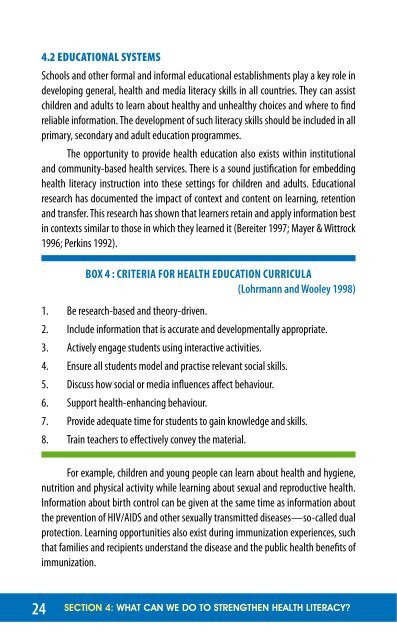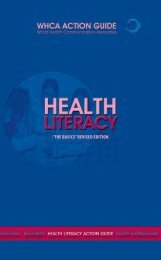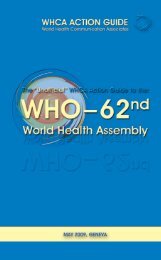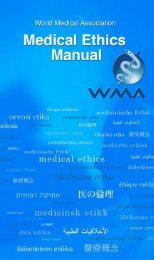Part 1 'the basics' - World Health Communication Associates
Part 1 'the basics' - World Health Communication Associates
Part 1 'the basics' - World Health Communication Associates
Create successful ePaper yourself
Turn your PDF publications into a flip-book with our unique Google optimized e-Paper software.
24<br />
4.2 educational systems<br />
Schools and other formal and informal educational establishments play a key role in<br />
developing general, health and media literacy skills in all countries. They can assist<br />
children and adults to learn about healthy and unhealthy choices and where to find<br />
reliable information. The development of such literacy skills should be included in all<br />
primary, secondary and adult education programmes.<br />
The opportunity to provide health education also exists within institutional<br />
and community-based health services. There is a sound justification for embedding<br />
health literacy instruction into these settings for children and adults. Educational<br />
research has documented the impact of context and content on learning, retention<br />
and transfer. This research has shown that learners retain and apply information best<br />
in contexts similar to those in which they learned it (Bereiter 1997; Mayer & Wittrock<br />
1996; Perkins 1992).<br />
Box 4 : criteriA for HeALtH eDucAtion curricuLA<br />
(Lohrmann and Wooley 1998)<br />
1. Be research-based and theory-driven.<br />
2. Include information that is accurate and developmentally appropriate.<br />
3. Actively engage students using interactive activities.<br />
4. Ensure all students model and practise relevant social skills.<br />
5. Discuss how social or media influences affect behaviour.<br />
6. Support health-enhancing behaviour.<br />
7. Provide adequate time for students to gain knowledge and skills.<br />
8. Train teachers to effectively convey the material.<br />
For example, children and young people can learn about health and hygiene,<br />
nutrition and physical activity while learning about sexual and reproductive health.<br />
Information about birth control can be given at the same time as information about<br />
the prevention of HIV/AIDS and other sexually transmitted diseases—so-called dual<br />
protection. Learning opportunities also exist during immunization experiences, such<br />
that families and recipients understand the disease and the public health benefits of<br />
immunization.<br />
Section 4: wHat can we do to StrenGtHen HealtH literacy?






